The following article appeared on July 6th in the Anderson paper ~
Sculpture
blessed outside Seneca church
 |
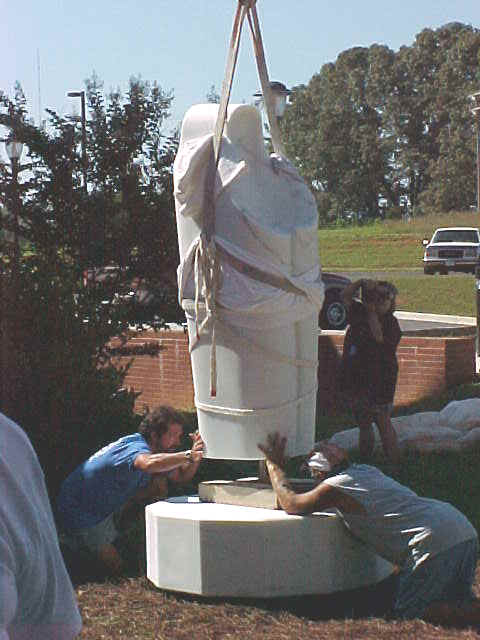 |
| Sculptor
Eric Johnson, right, and crane owner Joe Kennedy guide
Mr. Johnson's "Mary" to its pedestal at St.
Paul The Apostle Catholic Church on Bountyland Road in
Seneca. Mr. Johnson spent the past six months creating
the sculpture in front of the church. |
|
|
By David Williams
Anderson Independent-Mail
7/6/2001
SENECA - With the skillful
hands of the sculptor and a crane operator guiding its every move, a
six-foot marble statue of the Virgin Mary glided into its final
destination outside a Seneca church Thursday morning.
The placing of the statue sculpted by Eric Johnson drew applause
from 25 parishioners at St. Paul The Apostle Catholic Church on
Bountyland Road.
It was an emotional moment for some. Rose Stuck of Seneca was moved
to tears during the blessing of the work of art in front of the church
that serves about 700 families.
"It's truly magnificent, it's beautiful," she said
dabbing the corner of her eye with a tissue.
The Rev. Bernard Campbell led the group in a prayer service that
included a blessing of the 3,500-pound statue made of Colorado marble.
"It's been an inspiration," he said. "The experience
of meeting the artist. He's a wonderful teacher, especially with the
children."
Joe Kennedy, owner of Joe's Crane Service in Seneca, moved the
statue from Mr. Johnson's work area, also in front of the church,
about 20 yards down an embankment to the pedestal near the church's
doors.
Tom Kennedy, Joe Kennedy's father and a member of the church, said
he enjoyed watching the sculptor work on the project for the past six
months.
"It's been wonderful to watch the work in progress," he
said. "To see it take shape from a block of stone to become our
sculpture."
Mr. Campbell first saw Mr. Johnson's work in Colorado, and the two
began a correspondence that led to the highly recognized artist
leaving Oregon and moving to Oconee County to sculpt the statue for
the church.
"It's their statue," said Mr. Johnson, 70. "By
creating it here they get to be a part of it."
Mr. Johnson has held one-man shows in Vail, Colo., San Francisco,
Seattle and New York. His work also is in many outdoor public gardens
and private collections.
A sculptor for more than 40 years, Mr. Johnson has been so moved by
the project that he was baptized at the church last week, but despite
the outpouring of love and affection, the sculptor said he will return
to Oregon for now.
"I'm not sure for how long," he said. "We will back
off and take at look at it, it's a major decision, but me and my wife
Sherry are totally fascinated by the outpouring of hospitality."
|
The following article appeared May 28th,
2001
in the Anderson, South Carolina newspaper:
Sculpting
Mary; Oregon artist resides in Seneca as he creates contemporary
religious icon
 |
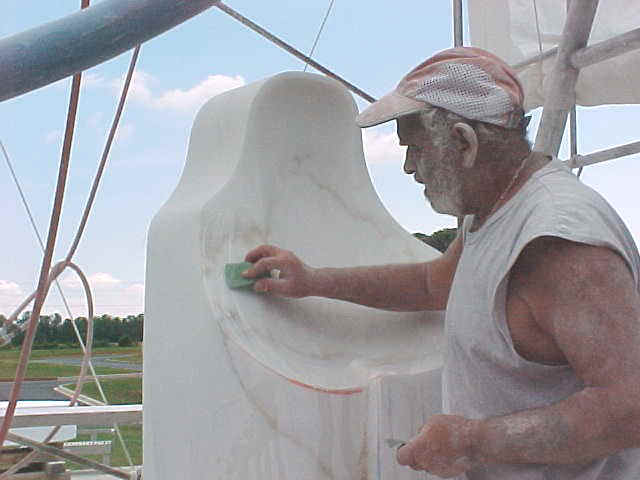 |
| Eric
Johnson polishes the sculpture of Mary he was
commissioned to create for St. Paul's Catholic Church
in Seneca. |
|
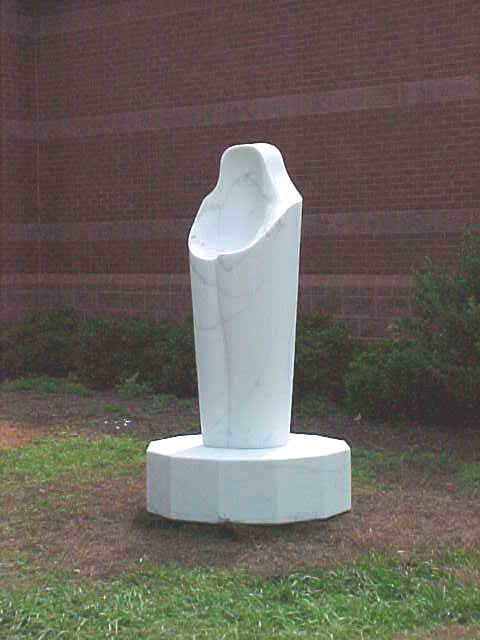 |
| A
six foot by 23 inch statue of Mary made out of
Colorado Yule Marble stands in front of St. Paul's
Catholic Church in Seneca. |
|
|
By Jake Grove
Anderson Independent-Mail
5/28/2001
The Virgin Mary is one of the
most recognizable figures in the world, what with Christians making up
roughly a third of its population. And although two millennia have
passed since the birth of Christ, Mary's image has changed little in
the minds of artists - dark hair, serene expression and blue robes.
St. Paul's Catholic Church in Seneca is getting something a little
different.
Prompted by the urgings of its priest, the parish members last year
commissioned Oregon artist Eric Johnson to sculpt a more contemporary
image of Mary. With the artist's studio full of abstract, flowing objects
d'art in marble, church members knew their Mary wouldn't be typical.
"It was love at first sight," St. Paul's Father Bernard
Campbell said of Mr. Johnson's work. Father Campbell saw it for the
first time at a church in Colorado. "I was just hooked."
Now, with one statue started and a second and final version on the
way, the congregation is expecting a figure with no discernible facial
features or limbs standing larger-than-life.
Mr. Johnson makes progress everyday toward completion of the
mammoth object in front of the church. Church-goers and on-lookers
walk past as the marble dust flies and chunks of rock fall to the
ground thanks to his chisel and hammer.
Every so often, he will stop to chat or ponder what move or strike
will be made next, and he works everyday. Everyday, that is, except
Sunday. When it is done, it will be a tall column with only a portion
being scooped out to signify an arm and head.
The 70-year-old artist has been sculpting in marble for 40 years.
His works have been displayed in galleries all over the country - from
New York to his current home state, Oregon. Since 1996, he has worked
close to his home in North Bend, Ore., but before that was working
near Aspen.
As soon as Father Campbell saw Mr. Johnson's work in Colorado, the
priest, envisioning a piece for the front of his own church in Seneca,
said he had to know who the artist was.
A correspondence began by e-mail after Father Campbell's sister,
who lives in Colorado, located Mr. Johnson. After Father Campbell
received a study (or model) of Mr. Johnson's concept for Mary, the
church made arrangements for the artist to complete a larger work.
Soon, Mr. Johnson found himself on a trek from the Northwest to the
Southeast.
"If I did this in Oregon, I could do it rapidly, but what
would that mean to the people here in South Carolina," Mr.
Johnson said. "Is it their sculpture or mine? By being here, they
get to take part in it."
The sculpture project has been a great undertaking of time, money
and energy, but Mr. Johnson said it was the only way he could imagine
doing the work at all. He is a religious man himself and wanted to
make the sculpture one with the church.
And the congregation has taken that to heart. During his initial
work, Mr. Johnson said the parishioners were not shy to tell him what
they thought. Some loved it, some hated it, but most were intrigued by
the work itself.
This abstract rendition of the Virgin Mary was something that
sparked discussion and feeling in people. The more he worked on it,
the more people talked. It was exactly what he wanted to get out of
this work.
"It's an emotional thing," Mr. Johnson said. "A
thousand years ago, people had to think so they could feel. Nowadays,
we are so sophisticated that we don't even stop to think, let alone
feel. If you really stop, and really look at this, you will feel if
you are willing to search for an understanding. This is not something
you can casually walk past."
Currently, a semi-complete version of the statue sits outside the
church, but that object won't be the final one for display. Its rock
was too soft and could not stand outdoor weather. So, Mr. Johnson even
now is probably working on the second one on Bountyland Road in
Seneca, but the concept remains the same.
"The empty arm on the left, there is no baby. That (Jesus) was
a gift to us from God," Mr. Johnson said. "The right arm
wraps around and is a come to me sort of concept."
A change from the first to the second sculpture is the tilt of
Mary's face. In the first, she was looking forward. In the second, Mr.
Johnson plans to have her looking down a bit at those looking up at
her face.
The base Mary will sit on is significant as well. It is done with
12 sides which represent, according to Mr. Johnson, the 12 disciples
and the 12 months in the Christian calendar.
Completion of the sculpture is expected to be around the end of
June or the beginning of July. The experience, so far, for Mr. Johnson
has been both exhilarating and draining, because when he does humans,
let alone one as important as Mary, he has to identify with them.
As there is so much to Mary, there is so much then to understand
and identify with.
"She was so very special to God," Mr. Johnson said.
"What courage and faith she had, and I am trying to identify with
all that.
"This woman went on to become the rock for the disciples
during a time when they really didn't know what they were going to do.
During the turmoil of the three days before Christ rose, Mary was one
of their strengths."
Now, he hopes, as does Father Campbell and St. Paul's, that this
fixture, set off the side of the main entrance, will be, not only a
rock, but a focal point of their church. Two rocks at one
establishment.
Eric Johnson's work can be viewed on the Web as well as at St.
Paul's Catholic Church in Seneca. You can find him at http://ejsculpt.tripod.com.
A diary and weekly update of his time sculpting Mary can be found at http://sculptureofmary.tripod.com.
|

The following article was published in the
monthly
parish newsletter Saints Alive in the March 2001 edition:
IMAGE,
AS IN IMAGINATION
By Paul Molony
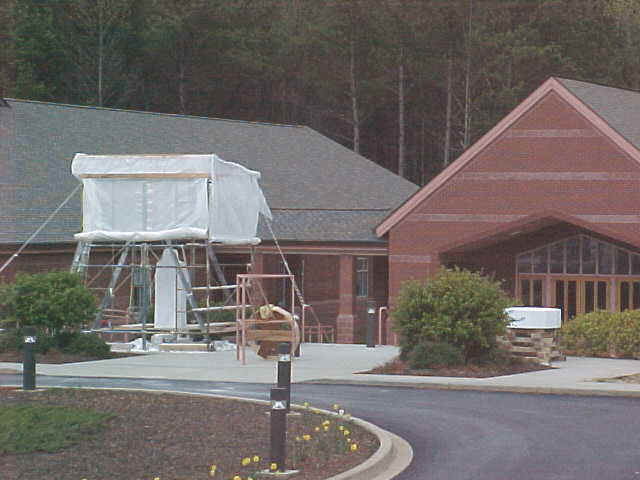
A tent is pitched on the terrace in front of St. Paulís. A rude cover of
visquene, not the protective embrace of a camelhair tent such as had sheltered
the Israelites for centuries, nonetheless, it is a shelter for the graceful
young maiden who is beginning to emerge. Clothed in pure white Colorado marble
suitable for the daughter of a desert sheik and not for Mary, the betrothed of a
simple Jewish carpenter, she begins to take shape. A protective sweep of her
mantle forms a cavity obscuring her face. "What will she look like?"
we start to ask.
"What do you want me to look like?" she responds. "Shall I
look like your mother? She gave you life, loved you, raised you. Or shall I look
like your wife who plays such a vital role in your family? Perhaps I shall look
like the homeless woman you saw on the street, face etched with sadness at the
loss of everything, of family, wandering the streets in search of shelter. Maybe
it will be the tear-stained face of a mother cradling the dead body of her
son."
Mary was all of these; the Mother of God, the wife of Joseph and yes, even
the homeless mother as the Holy Family fled into Egypt escaping the slaughter of
the Holy Innocents by Herod. She definitely was the tear-stained mother of a Son
who had endured the cruel death of the Cross.
All of these images are possible and appropriate for, as we now know, our
statue of the Virgin will have no face. In the words of the sculptor, Eric
Johnson, he does not feel worthy to look on the face of the Mother of God. What
he wants is for us not to see Mary visually but rather, to see her emotionally.
He wants to make us stop, think and feel. His concept is evocative. The left arm
is tender, draped in her mantle, offering us the gift of Christ, her Son and our
God. The right arm is strong, appealing to us to come unto her.
Even the pedestal, an integral part of the concept, is evocative as it will
be wide enough to provide seating. "Come sit here at my feet. Tell me of
your dreams and let me tell you of my Son." Just think how marvelous it
will be when we see some child perched there talking to his mother, Mary.
Beyond this, the image is all left to our imagination. Perhaps this is as it
should be, as we know almost nothing of the historical Mary, only a few
quotations and nothing of a physical description.
Eric and his wife, Sherry, truly want this to be our sculpture. It is
being done here, on site, rather than in the artistís studio in Oregon. Even
the finishing polish will be a community effort with parishioners encouraged to
join in for the final rub. Eric and Sherry have done much to integrate
themselves into our parish community. Youíll see them at Mass, at parish
gatherings, and youíll always find Eric in his tent ready to talk about our
statue or whatever you might find interesting.
In talking to him, I found it interesting that he did not start out to be a
sculptoróin stone, at least. He has pretty much always been carving. The gift
of a small whittling knife as a child started him into wood. Then there was an
interim period of Army service in his native Canada and, for a time, working in
industry here in the States before he happened to pick up a book about sculpting
stone. He took the book on a hiking trip, read the whole thingóand the rest,
as they say, is history!
To hear him talk of sculpting, which he calls, with a grin,
"intellectual manual labor," you might not realize the effort that
goes into the project. The work site at the moment seems equal parts
construction and destruction. White marble dust and chunks of stone litter the
area.
Eric most of the time looks like a dusty furry ghost. The whir of power
drill and saws is more pervasive than the delicate tap of the chisel, but a
cursory glance in his tool bag proved their presence.
I have found it very interesting having this image developing before my very
eyes. Each time I arrive a St. Paulís I am curious to note just what the
progress has been. When the last blow with the chisel rings out, you can rest
assured that I will be there in dusty glory joining in the polishing of our
statue.

The following article appeared January 30,
2001
in the Daily Journal, Seneca, South Carolina:
Eric Johnson works on 6-foot Mary
for St. Paul
By Robin Boyle
Features Editor
SENECA Ė The man is completely covered in fine white dust.
It settles in his hair and beard, and in the deeply etched laugh lines crinkling
around his eyes.
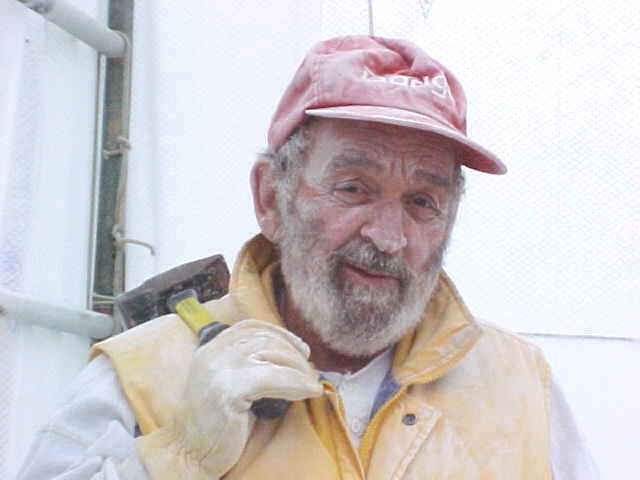
Eric Johnson, sculptor
He carefully adjusts his nose and mouth protector and raises
the saw, powered by an air compressor. The spinning blade bites into the hard
stone and a piece the size of his hand breaks cleanly from the three-ton slab of
marble.
Sculptor Eric Johnson stands back from the stone and takes a
deep breath as he removes his mask. He is a professional and careful about
keeping the dust from his lungs. He is carving a base that will hold a six-foot
figure of Mary commissioned by the local diocese of St. Paul The Apostle
Catholic Church in Seneca. The artist is working in front of the church. The two
slabs, one for the base and one for the sculpture, are protected by tarpaulin
walls.
When Johnson is finished with the base he will spend the next
several months painstakingly chipping and sawing away the abstract figure of
Mary from a 5,000-pound piece of Colorado marble. He will invite church members
to help him in the final polishing.
A two-foot model of the final sculpture stands on a table
inside the church entrance. The marble is cool to the touch, smooth and fine
grained.
"Sculpture is meant to be touched," he said,
"Touch it to see it, feel it for understanding."
Johnson completed the model in about five weeks at his home
in Oregon, and then shipped it to the church for approval. Not everyone in the
congregation understands the abstract figure, he said, some prefer a more
traditional depiction of the Mother of God.
"Iím not worried, though. The idea is to capture
attention," he said.
He reached out to the model and as he rested his hand on the
translucent stone he said, "The concept of empty arms represents the gift
of Christ. The deep recess of her face means although you cannot see her face,
she can see us."
Because of the translucent properties of the marble, in
strong sunlight the small figure seems to glow. The same thing will happen with
the full-scale sculpture.
Johnson and his wife Sherry Johnson are staying at a home in
Keowee Key, loaned by a member of the congregation, while he finishes the piece.
It will take at least several months.
He said he has always sculpted, and has felt led from one
medium to another, and from one project to the next, throughout his life.
"I whittled wood as a kid. I went off to Korea, and when I came back I
bought a wood carving set. Then it just got out of control," he laughed.
A little later a friend gave him a book about stone
sculpting. He took the book and went backpacking alone into the Oregon forests.
"By the time I hiked out, I had memorized the book," he said
When Johnson started sculpting in marble decades ago, he said
he was one of only about three marble sculptors in America, not including
tombstone carvers. There are many more artist working in the difficult medium
now, he said.
The stone, called white Colorado Yule marble, is quarried in
the Rocky Mountains. He chose the slabs and had them shipped to Seneca.
"Colorado stone is the purest, strongest and most
durable of all marbles," Johnson said. "Italians buy incredible
amounts, and the American government buys it for tombstones for veterans."
Johnson hasnít taken on a major commission for about three
years. He had contracted cancer and for a while had put his work on hold. Now in
recovery, he said he asked God to show him what he should be doing. Although
many commissions were offered, about five days later he received an e-mail from
Father Bernard Campbell of the Paulist Fathers in Clemson.
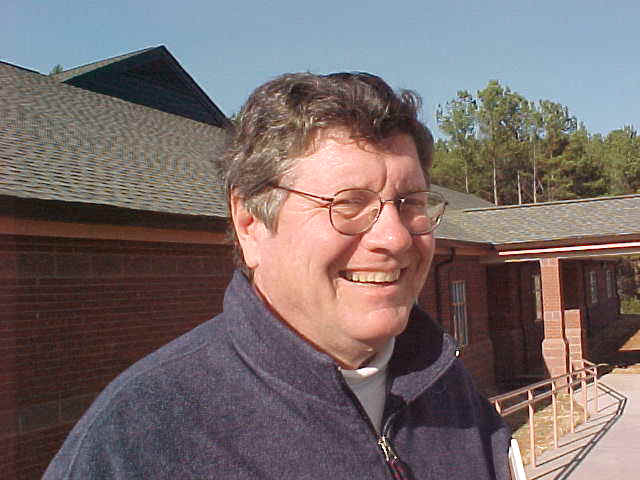
Father Bernard Campbell
Father Campbell said he had been substituting for another
priest at a church in Carbondale, Colorado, last summer when he saw a sculpture
by Johnson. He tracked him down, found his web page on the Internet, and
contacted him about doing a commission work for St. Paulís in Seneca.
"I figured that was the sign I was waiting for,"
Johnson said.
Father Campbell had been visiting his sister in Old Snowmass.
She is a religious educator for two parishes in the Rocky Mountains. "Old
Snowmass is the poor section of Aspen" Campbell laughed. When he was asked
to say Mass in nearby Carbondale he saw one of Johnsonís works.
"I fell in love with the statue, I wanted to put my arms
around it and take it home," Father Campbell said, "I asked my sister,
who did it? But she didnít know. By the end of the summer she called with his
e-mail address. He was in Oregon. I wrote him to say, I like your work, we might
like to do something for our church, how much will you charge? He e-mailed me
back, telling me about himself and his recent illness. But he didnít answer my
question. That was the old hook. So I wrote and said, you didnít answer my
question. At that point he wrote back and said, why donít we come there and
build it.
"I thought of the educational possibilities, not only
for our members, but for anyone who wishes to stop in and look at this guyís
wonderful spirit."
Father Campbell said when he met Johnson he knew he fulfilled
the bill completely. "He was obviously solidly built, not an effete artist.
The essential quality of any art no matter what it is, whether itís music,
sculpting, painting, or dance is to make you notice, to make you aware of not
only the thing but of yourself being aware. Art is absolutely crucial to make us
better observers of life and of ourselves, to become more alive."
After he shipped the model to the church, the church asked if
they could also purchase the model. In most cases, the artist keeps the model.
"I told them Ďnoí at first, then I thought I would
let it go. If you keep your own art you donít grow beyond that point. You have
to let go to grow."
Johnson is writing a book on the theory of sculpting in
marble.
"I was tired of listening to two-dimensional artists
telling three-dimensional artists what to do, " he said. "Theory is a
tool that can be used."
Johnson attended several art classes when he first started
out, but found that his visions couldnít be confined to a classroom. He
studied anatomy, but says he leaves the real for the abstract in his work.
"When you work in reality and you take it a step further to abstract, it
can become more real, more truthful," he said.
Johnson was born in Nova Scotia, Canada, and still retains a
little of his lilting northern accent. In 1982 he opened the Redstone Art Center
in the Rockies, near Aspen. Carving in his studio next to the gallery, he has,
over the years, become famous. Drawn back in 1996 to the Oregon coast where he
once lived, he and his wife now live and work on 20 acres where he can stay
close to the environment where he draws his inspiration.
His web page may be viewed at: http://ejsculpt.tripod.com
. Sherry is finishing a web page especially for this one project that may be
viewed starting today. Its address is: http://sculptureofmary.tripod.com
. It is also linked to Johnsonís home page. Everyone is welcome to visit the
artist as he works at St. Paul, 170 Bountyland Road.

This page updated on 07/07/2001
